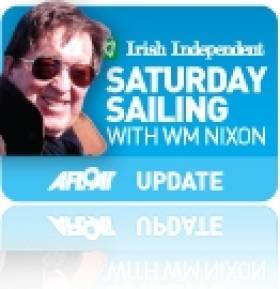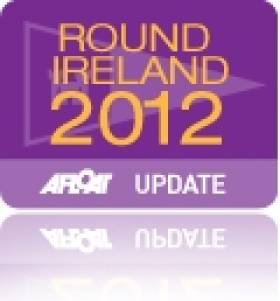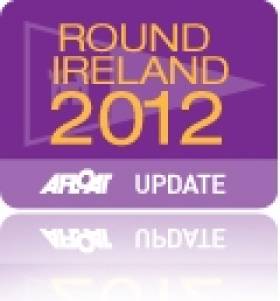Displaying items by tag: Wicklow Sailing Club
There are just over 10 weeks to go to the start of the 17th Round Ireland Yacht Race writes Peter Shearer, Commodore of Wicklow Sailing Club.
There is talk of a Volvo 70 chasing line honours, although the record of just under two days and 18 hours established by Mike Slade in ICAP Leopard in 2008 will be hard to beat.
However, a Volvo Ocean yacht has already been entered. This particular 60 ft yacht was built in New Zealand for the 2001-02 Volvo Ocean Race and sailed at that time as Djuice Dragons.
In June 2012 it was christened Team Jolokia and became part of a completely new project. "The goal of Team Jolokia is to show that diversity, if well-integrated, can be a major lever for progress, ..." and the crew is selected to exemplify diversity. Team Jolokia faces a busy summer; after the Round Ireland, they will compete at Cowes Week, at Voiles de St Tropez and also in the Middle Sea Race.
Race organiser Theo Phelan is delighted to welcome Team Jolokia to the Round Ireland and he says that precedence shows that the bulk of the Round Ireland entries tend to be made in April.
This race of 704 nm which circumnavigates the island of Ireland, leaving all islands to starboard except Rockall, starts at Wicklow at 14.00 hrs on Saturday 28th June.
Entry can be made at www.roundireland.ie .
Round Ireland Race – Wicklow's Child Outgrows the Family Home
#roundireland – With the announcement that Round Ireland Race organisers Wicklow Sailing Club have taken on Dun Laoghaire's Royal Irish YC as Associate Club for this year's race on June 28th, W M Nixon looks back on 34 years of a pivotal event, and suggests that the new twinned arrangement deserves full support and increased participation.
"Mixed feelings" defines the reaction to the announcement that Wicklow Sailing Club have taken on Dun Laoghaire's Royal Irish Yacht Club as a partner in staging the biennial Round Ireland Race. Until now, even though the largest boats tended to be Dun Laoghaire-based before the event, there's no doubting the real scene of the action was twenty-one miles to the south in a characterful little river port where the unique and very special pre-race atmosphere was charged with emotion and tangible memories of previous stagings of this often epic event.
But in the 34 years since the first race was sailed in 1980, boats have got bigger, and media coverage and tracking of the race have become much more sophisticated. Expectations have been raised. Yet Wicklow Harbour has stayed the same. Indeed, the likelihood is it's going to be even more of the same as the pickup in the economy continues and the number of ships using Wicklow – some of them astonishingly large for the place, and many of them discharging or loading decidedly anti-social cargoes – starts to increase again.
In an age when local trade, exports and jobs are more important than ever, a biennial special-interest sporting event which hopes to transform a busy little commercial port into a yacht harbour of international standard, even for only a few days, is going to receive decidedly mixed messages both from the neighbourhood community, and from those who hope to take part in the race.
With proper recreational boat berthing facilities close to the south in Arklow, and northwards at both Dun Laoghaire and now Greystones, the fact that berthing for anything more than a small handful of visiting boats is inadequate in Wicklow by international standards becomes a bigger drawback with every staging of a race which is at the very heart of Irish sailing.
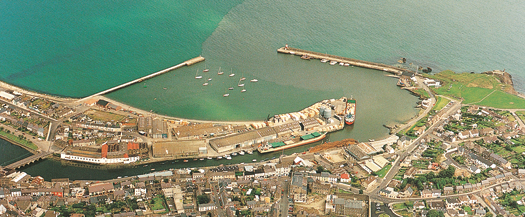
Wicklow Harbour in the summertime, with two substantial ships in port, and visiting yachts rafted up at the outer pier. Photo by Kevin Dwyer courtesy of Irish Cruising Club.
In fact, it was when the peak turnout of 53 boats was achieved twenty years ago that it was clear something needed to be done if the race's growing international stature was going to be maintained. But in 1994, the improvement of facilities in other ports was still at an early stage, so people accepted that being in over-crowded rafted-up berthing in a commercial port setting was part of the Wicklow Round Ireland Race thing.
And of course, the ultimate Wicklow Round Ireland thing was the very fact that a little local sailing club, thanks to one or two key enthusiasts and visionaries supported by loyal teams of clubmates, had been able to pull off the audacious coup of making a non-stop round Ireland race happen, and keep it happening, and successfully too, by making its existence the core tenet of their club's existence.
Other bigger clubs and sailing organisations had made noises about staging a round Ireland race in times past, and there'd been an early three-stage circuit from Ballyholme in 1975. But it was a once off. Yet when Michael Jones of Wicklow announced that his club would be running the first non-stop Round Ireland Race in June 1980, and that come hell or high water they'd stage it biennially thereafter, his sheer determination, and the fact that Wicklow is a significant distance from the then-hidebound Dublin Bay sailing establishment, meant that offshore racing folk with a bit of the rebel in their makeup leapt at the chance to do something completely new.
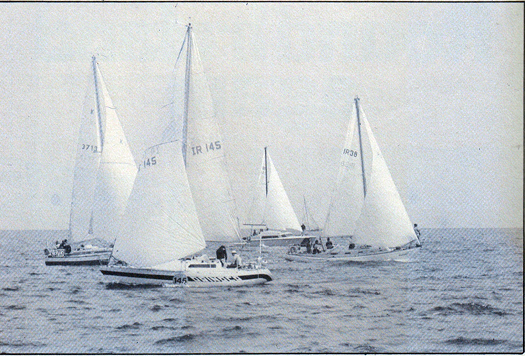
Pre-start manoeuvring at the first Round Ireland at Wicklow, June 28th 1980. Boats are (left to right) the High Tension 36 Force Tension, Shamrock Orinoco, catamaran Snowball, and the Rival 34 Raasay of Melfort.
The challenge attracted thirteen starters from many parts of Ireland, including two round Ireland junkies who had already done that first three-stage race from Ballyholme in 1975. They were Jim Poole from Dun Laoghaire, who'd come second in 1975 with his Ruffian 23, but now had the Ron Holland Nicholson Half Tonner Feanor, and Brian Coad from Waterford, who'd done the first race "in his own good time" with a Folkboat, but now was skippering the Rival 34 Raasay of Melfort, very much a cruising boat but she was to become a round Ireland regular.
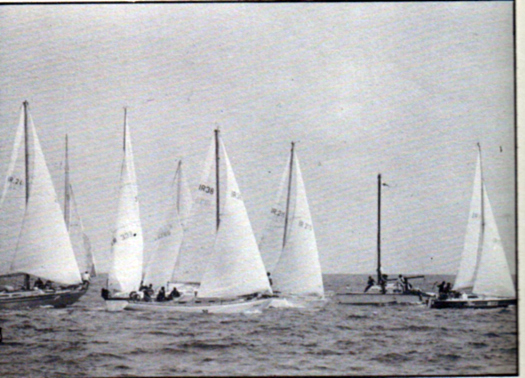
The start. High Tension is already on her way, Brian Murphy's Crazy Jane leads the next bunch from Tony Farrelly's Crystal Clear, Brian Coad's Raasay, and Dave Fitzgerald's Partizan, with Feanor trying to get the right side of the Committee Boat as the tie pushes her south.
The best of a cautious start on Saturday June 28th 1980, in a sluicing ebb and a light to moderate east nor'east breeze, was made by the de Ridder-designed 36ft High Tension-class One Tonner Force Tension, skippered by serial offshore racer Johnny Morris, the boatyard owner from Pwllheli in North Wales. Next across was persistent boat-modifier Brian Murphy from Howth with his own-built David Thomas-designed 28ft Hydro, a boat which was almost permanently in a state of Work in Progress, and eventually became a 31-footer with a needle mast which her ingenious owner was to assemble from bits of scrapped Dragon masts.
After that they came in a rush led by the Cavan doctor-entrepreneur Tony Farrrelly with his Shamrock Crystal Clear (Cavan Crystal was one of his many ventures), closely followed by the Waterford veterinarian Brian Coad with his Rival 34, and then came Galway mining engineer Dave Fitzgerald with his handsome Holman & Pye 41 Partizan, a true cruiser-racer of that era.
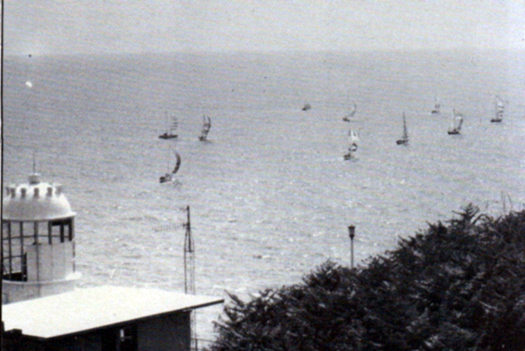
Saturday June 28th 1980, and spinnakers set south of Wicklow Head as the fleet of thirteen boats sets off on the first Round Ireland Race.
They'd a spinnaker broad reach for a while after getting past Wicklow Head, but eventually the wind headed them, and in the lead the Welsh team on Force Tension found themselves hard on the wind for 75% of the course. Down in the body of the fleet, a very determined race was being sailed by Jim Poole with Feanor, his National YC crew including Enda O'Coineen who's originally from Galway, so it was ironic that for much of the race the 30ft Feanor was neck-and-neck with the much larger Galway boat Partizan.
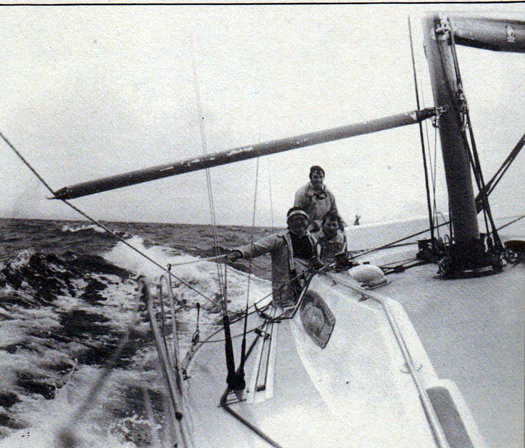
Feanor revelling in fair winds off the west coast during the first Round Ireland Race. Photo: Enda O Coineen

Jim Poole on Feanor off Aranmore in Donegal, neck-and-neck with the larger Partizan. Photo: Enda O Coineen
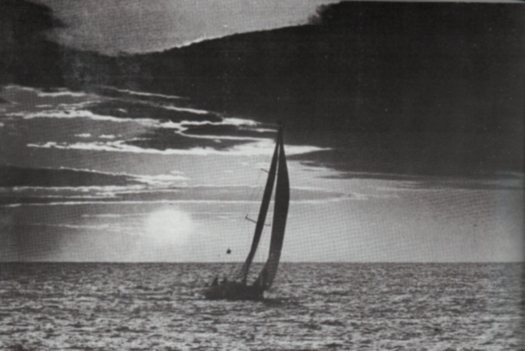
The money shot. Dave Fitzgerald's Partizan from Galway is the first star of the now-traditional image of a boat coming out of the dawn to finish the Round Ireland Race at Wicklow
Force Tension came to the finish in the small hours of the Saturday morning after 5 days 15 hours 2 minutes and 21 seconds, a very leisurely time by today's standards. Partizan was next in two hours later, and as the dawn was breaking the Galway crew were first ever to star in that classic Wicklow photo of a round Ireland finisher coming in with the sunrise. Feanor was in only two hours later, and immediately corrected in to a formidable lead on IOR which she held despite the conditions now favouring slightly lower-rated fast-reaching boats such as the Hustler 35 Red Velvet (Dermod Ryan, RStGYC).
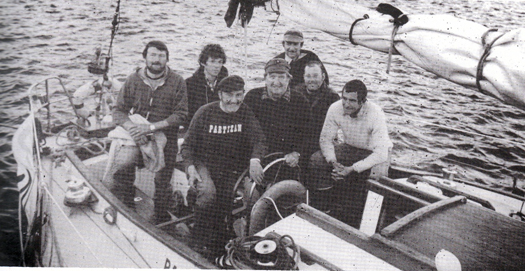
Dave Fitzgerald (fourth right) and his crew aboard Partizan in the early morning in Wicklow shortly after finishing the first round Ireland Race. Partizan competed a number of times during the 1980s, and usually had a bet on with Patrick Jameson's similarly-sized Swan 40 Finndabar.
However, being the first time round, Wicklow SC also had their own handicap system as they'd to include one multi-hull entry, the catamaran Snowball. Under this "Race Handicap", the winner was Brian Coad's Raasay of Melfort, despite the fact that this very comfortable boat didn't get in until the Sunday.

History is made. The first set of published results of the first Wicklow Round Ireland Race 1980
With a retiral rate of only 20% - which reflected very well on Wicklow SC's pre-race qualifying and scrutineering process – the Round Ireland seedling had been properly planted, but now it needed encouragement and nurturing. That came big time with the next race in 1982, when Denis Doyle from Cork turned up with his 1981 Crosshaven-built Frers 51 Moonduster, and his involvement encouraged other noted larger international contenders such as Ciaran Foley's Storm Bird. But while other skippers came and went, The Doyler gave his whole-hearted support to the Wicklow Round Ireland Race for many years, and he was an example to everyone else, as he and his hugely-supportive wife Mary stayed in a B&B near the harbour for the pre-race days, and at every turn ensured that the race team in WSC got the encouragement and credit they deserved.
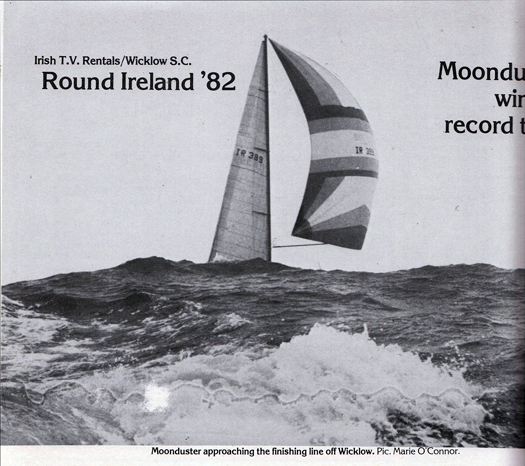
Moonduster comes to the finish line in 1982 in a brisk nor'easter – a scan from Afloat magazine August 1982.
Moonduster in turn put in stellar performances which gave the event its proper glamour. In 1982 she set a good course record despite a nor'east gale giving the leaders a right pasting along Ireland's north coast. But it was 1984 when she sailed the definitive round Ireland record race in fresh to strong west to nor'west winds which curved at just the right time to enable the big varnished sloop to fly. "We saw off an entire Irish county in every watch" was how navigator John Bourke (later the Commodore of the RORC) was to put it after the finish.
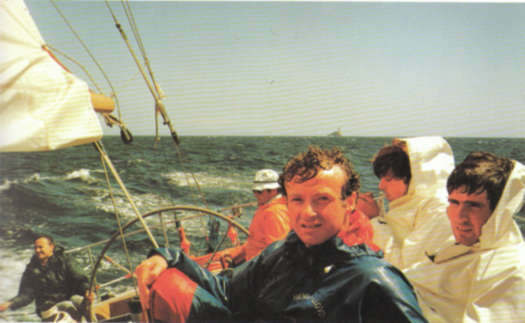
The Fastnet astern, and it still only Sunday.......a carnival atmosphere aboard Moonduster as she shapes her course for Mizen Head in 1984's record-setting race, with Neil Hegarty to lee on the helm, Brendan Fogarty and Grattan Roberts in foreround, and is that Donal McClement behind them?
Moonduster's 1984 record of 3 days 16 hours 15 minutes and 43 seconds was a prodigious time for a mono-hull sailing a circuit course at a pre-ordained time, its quality underlined by the fact that it took a 60ft catamaran – Robin Knox Johnston's British Airways – to shave a bit off it in May 1986 with a designated own-time-choosing challenge. As for mono-hulls in the Round Ireland, it wasn't until Colm Barrington came along with the Volvo 65 Jeep Cherokee that The Duster's time was bettered, and it took a hundred footer to better it yet again with the current record set by Mike Slade's Leopard – helms including Gordon Maguire - in 2008.
But while records by superstars captured the headlines, for the vast majority of sailors the Wicklow Round Ireland Race really has been a matter of taking part personally while doing the best you can. And in its thirty-four years, the event has built up an extraordinary mythology in which the unique and sometimes maddening situation in Wicklow's crowded river has been seen as part of the mix.
But recent years have also seen a real game changer with the Round Ireland Race becoming recognised as part of the RORC Championship, up there with the Fastnet and the Middle Sea Race in terms of points loading.
In times past, every time a big boat was brought in by a sponsored crew, they simply had to be based in Dun Laoghaire, as Wicklow hadn't the space to accommodate them in fully-sheltered berthing, while the business of getting sponsor's guests anywhere near the boat was an unattractive proposition from an old-fashioned and crowded pier.
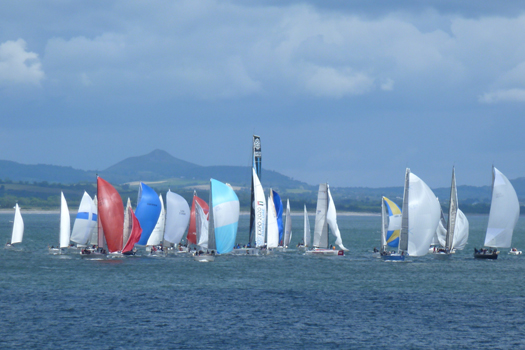
The start of the Round Ireland Race has become something special. This is 2012's race with the Wicklow scenery briefly in some sunshine in a very poor summer. Photo: W M Nixon
Oddly enough, though, the economic recession continued to preserve the old way of having things essentially based around Wicklow, with Dun Laoghaire only as an add-on. There simply haven't been the big money sponsored large yachts taking part, while the hyper-keen entries from the main body of the international RORC fleet, such as Piet Vroon's Tonnere de Breskens from The Netherlands and the Gouy family's Inis Mor from France (and Clifden!) were so keen to race, and so understanding of local enthusiasm, that they happily went along with the traditional setup.
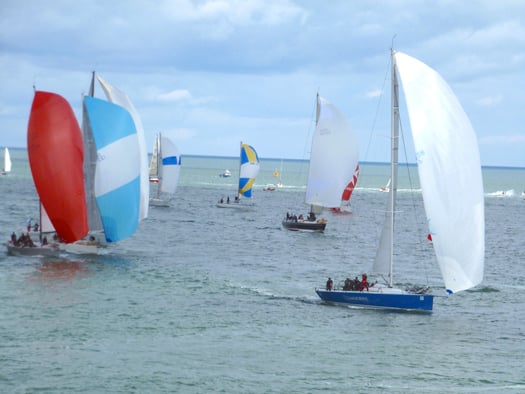
Closing in for the gybe under the cliffs south of Wicklow town in 2012, round Ireland racers include two contenders in the RORC Championship, the Ker 39 Inis Mor (red gennaker) and the blue-hulled Tonnere de Breskens. Photo: W M Nixon
However, the economy is on the move again, and it's reckoned interest in the Round Ireland Race could blossom much more rapidly and strongly if the RORC support could be backed by the provision of pre-race berthing facilities which approach international standard. But set against that, after so many successful stagings of the race, Wicklow SC's Round Ireland Race experience and database is unrivalled, while the club's commitment to its town and quaint little port is total.
Whether the connection to the Royal Irish YC in Dun Laoghaire in the linkup's proposed form is the longterm solution remains to be seen. But if the sheer goodwill which permeated the reception in the RIYC announcing the partnership is anything to go by, then it will work.
And there's no doubt the Royal Irish has the ideal setup for show-casing high profile entries before the race in the sort of scenario top-end sponsors dream about. Yet it's ironic, as it it's all a case of Blessed are the Grumblers, for They Shall Inherit the Earth. It's largely forgotten now, but when Dun Laoghaire Marina was finally installed to become an overnight success after 25 years of struggling by its proponents, some of the most formidable opposition had come from a very old Old Guard within the RIYC membership, largely among the pavilion membership who liked to enjoy the view of boats bobbing about on moorings as they enjoyed their leisurely lunch.
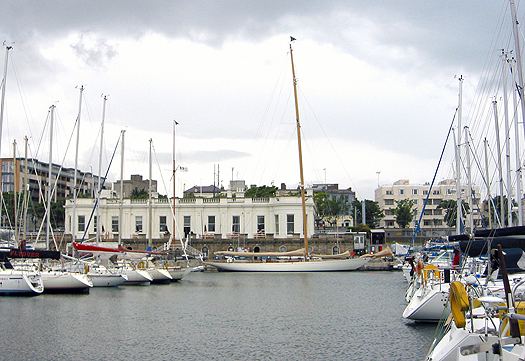
The Royal Irish YC provides the unbeatable combination of an historic clubhouse beside a modern marina. It's ideal for showcasing boats, as demonstrated here by the 70ft classic Hallowe'en, which was line honours winner in the 1926 Fastnet Race. Photo: W M Nixon
Yet now, here is the historic clubhouse with a world standard marina to which they even have their own private secured access. In your wildest dreams, you couldn't have visualised a better setup for allying modern facilities with a traditional clubhouse totally imbued with Irish and international sailing history at the highest level.
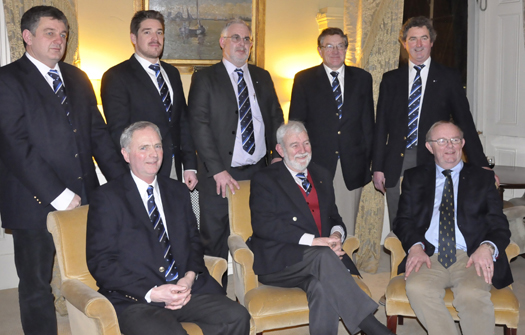
At the reception for Wicklow SC's Round Ireland partnership with the Royal Irish YC in the RIYC clubhouse were (left to right, back row) David Ryan, Kevin Johnson, John Harte and John Johnson (all WSC Round Ireland committee), and front row Peter Shearer (WSC Commodore), Theo Phelan (Round Ireland Race organiser) and Paddy McSwiney (RIYC Commodore).
So in choosing the RIYC s their race partner, and in planning to set up an auxiliary race office within the RIYC clubhouse while retaining the start and finish line at Wicklow, the Wicklow SC people have chosen well. In its three decades-plus history, the Round Ireland Race has had only four organising secretaries – Michael Jones, Fergus O'Conchobhair, Denis Noonan and now Theo Phelan. It is the latter who is powering the Dun Laoghaire linkup, and it moves the Round Ireland Race onto a higher plane of development potential, aiming at a hundred entries by 2016, with this year's race on Saturday June 28th seen as the first step in a new stage of the journey.
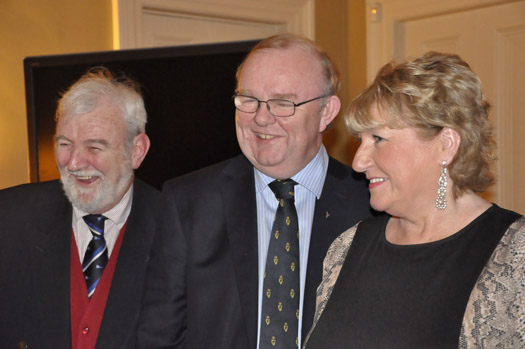
Theo Phelan, David McSwiney and Sadie Phelan, President Wicklow SC
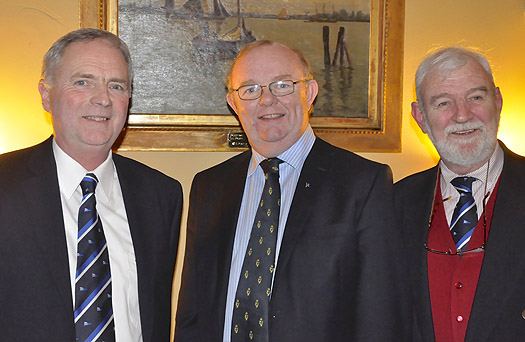
Peter Shearer, David McSwiney and Theo Phelan at the Round Ireland reception in the Royal Irish YC.
It is up to the rest of the Irish sailing community to support them, and to take part if at all possible. In fact, dare we say it, but you aren't really a proper Irish sailor unless you've at least started one Round Ireland Race, and having a few in your CV is good for the soul.
Do it, and you'll find you care very much indeed that the Round Ireland Race should continue to grow and prosper. Those of us with Round Ireland experience will know only too well what a tricky path it is that the organisers have now set themselves. Let them be encouraged by knowing that, while our heads may be in Dun Laoghaire, our hearts are in Wicklow.
Round Ireland Race Ties the Knot in Dun Laoghaire to Boost Race Numbers
#roundireland – Round Ireland race organisers have increased the maximum race entry to 100 yachts following what has been deemed 'an historic expansion' of the Round Ireland Yacht Race that will facilitate yachts of all sizes taking part, it was announced this evening in Dun Laoghaire.
As previously reported by Afloat.ie in October, Wicklow Sailing Club, which organises the race, has linked up with the Royal Irish Yacht Club to provide full pre-race management facilities in Dún Laoghaire for the larger yachts which are unable to berth in Wicklow Port. Through the introduction of a fully-equipped shore base in Dún Laoghaire, larger boats can now berth and enjoy full pre-race facilities in advance of the Race departure from Wicklow.
The Round Ireland Yacht Race is now in its 34th year and is Ireland's premier offshore sailing race attracting entrants from across Europe and as far afield as Russia, the USA and New Zealand. It will depart Wicklow on Sunday 28th June 2014 at 2.00 pm
There will be no changes to the Race itself, other than increasing the maximum number of entries from 75 to 100 yachts. Wicklow Sailing Club will continue to run the race under the auspices of the Royal Ocean Racing Club and the Race will start and finish in Wicklow.
Organisers at Wicklow Sailing Club expect that this landmark expansion of the Round Ireland through the new association with the Royal Irish Yacht Club is set to give the Race a significantly higher international profile and attract the attention of the larger, ocean racing, fleet.
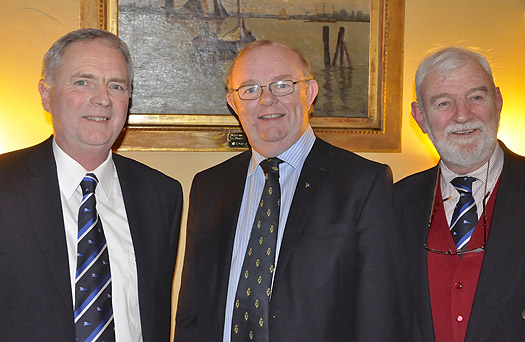
Peter Shearer, Commodore Wicklow Sailing Club, Paddy McSwiney, Commodore Royal Irish Yacht Club, and Theo Phelan, Race Organiser at the launch of the 2014 Round Ireland Yacht Race at the Royal Irish Yacht Club in Dún Laoghaire.

Theo Phelan, Race Organiser , Paddy McSwiney, Commodore Royal Irish Yacht Club, and Sadie Phelan President Wicklow Sailing Club
Race Organiser, Theo Phelan:
"Discussions on expanding the Race have been ongoing for some time arising from expressions of interest from owners of the larger offshore racing yachts seeking entry conditions to our race. Internationally, completing the race is considered a significant feat as the race is one of the most gruelling and challenging sailing competitions in the yacht racing calendar.
"The course, starting and finishing in Wicklow, brings entrants through widely different sea types and coastlines, from the Atlantic ocean to the more sheltered Irish Sea, with difficult tidal gates, particularly around the North Eastern coast and navigational challenges requiring day and night tactical decisions at every change of forecast."
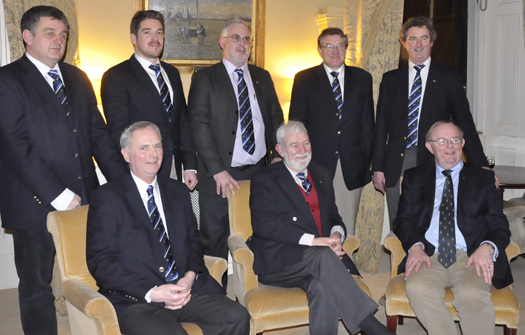
Round Ireland Race committee: (back row) David Ryan, Kevin Johnson, John Harte, John Johnson and Charlie Kavanagh (front) Peter Shearer, Commodore Wicklow Sailing Club, Theo Phelan, Race Organiser and Paddy McSwiney Commodore Royal Irish
Whilst 2014 could see an increase in larger yachts entering the Round Ireland, organisers say that the changes introduced to the management format this year should attract a significantly greater interest in entries for 2016 and subsequent events:
"Huge planning goes into preparing for this race as there are very strict qualifying criteria for crew, yachts and equipment. Knowledge of medical response, survival at sea certificates and a minimum of 300 nautical mile offshore experience are basic to entry as both crew and yacht need to be prepared for all conditions. In 1994 for example, there were 17 retirals from the Race arising from adverse weather and equipment failure. A year's planning to participate in this race would not be unusual and already there will be skippers of larger yachts putting plans in place for 2016."
The Round Ireland Yacht Race is the only RORC race based in Ireland. It is regarded as equivalent in terms of rating points to the Fastnet Race, the classic offshore race, which runs in alternate years to the Round Ireland.
In a final comment the Commodore of Wicklow Sailing Club, Peter Shearer, stated: "The endorsement of the Royal Ocean Racing Club, the largest yacht racing organisation in the world, together with the stated support of the Irish Sailing Association for our new venture bodes well for the forthcoming event in 2014 and for our endeavour to develop the full potential of the Round Ireland Yacht Race."

John Sinnott, president Wicklow Town and District Chamber of Commerce with Dutch Sailing guests Linda and Ronald Koelink
#rdirl – The world's largest yachts will be able to contest the Round Ireland offshore race in June thanks to a new formal arrangement drawn up last month between race organiser's Wicklow Sailing Club (WSC) and the Royal Irish Yacht Club (RIYC) in Dun Laoghaire.
The new arrangements will see entries berthed at the RIYC in Dun Laoghaire harbour for scrutineering prior to the biennial 704–mile race start off Wicklow harbour on June 28th.
Larger boats have been unable to berth in the confines of Wicklow harbour, a factor WSC believes has restricted the growth of the Round Ireland fleet. 'It means we can now encourage larger boats that have shown an interest in competing but we have been unable to cater for in Wicklow' harbour, WSC Commodore Peter Shearer told Afloat.ie.
It is understood WSC has entered in to a formal agreement with RIYC for the provision of services prior to the race at Dun Laoghaire, a harbour that can take yachts of any size.
Round Ireland Yacht Race 2014 Start Date & Time is 2pm, Sat, June 28th
#rdirl – The 2014 Round Ireland Yacht Race, a highlight of the Irish summer sailing season starts from at 2pm on Saturday, June 28th 2014. A full Round Ireland notice of race has been published here.
Defending Champ Gets off to a Great Round Ireland Start
#RoundIreland– Sole Dutch entry Tonnerre de Breskens skippered by Piet Vroon looked every inch the defending champion when she won the reaching start of a crowded Round Ireland start line in Wicklow this afternoon. SCROLL DOWN FOR MORE PHOTOS BY BOB BATEMAN.
Vroon took six or seven gybes for more breeze before reaching Wicklow head just minutes after the start.
The Dutch yacht , a Ker 46, was followed closely by Laurent Gouy's Ker 39 Inismor and the J133 Spirit of Jacana from Carrickfergus. Also taking the route closest to the shore was Adrian Lee's canting keel Cookson 50 Lee Overlay.
Legendary Irish round the world yacht Green Dragon (the biggest in the fleet) took advantage of the light to medium north westerly winds to hoist a spinnaker and went immediately offshore to clearer air after a congested start of the 2012 Round Ireland Yacht Race start. There was at least one collision at the committee boat end of the line just moments before the gun.

The start of the 2012 Round Ireland. Photo: Bob Bateman
The international 38 boat Round Ireland fleet departed as per schedule at noon, ahead of them up to a week long 700-mile sailing odyssey all the way round the coast of Ireland.
The fleet were tightly packed at Wicklow head on a shy port reach with most setting spinnakers.
Old warhourse and double race winner Cavatina took up her position at the rear of the fleet, settling in for her first night at sea and the first tactical challenge presented at Tuskar rock.
Next Round Ireland fleet update tomorrow morning as the fleet move along the Cork Coast
Galwegians Rattle Round Ireland Cage
#roundireland – The Galwegians are rattling the round Ireland cages. Tomorrow's noon start of the biennial Round Ireland Race from Wicklow will see a strong mid-fleet challenge from Galway University with a college-crewed Reflex 38, boosted by a front-of-the-pack show by the veteran Volvo 70 Green Dragon, captained by intrepid Galway skipper Enda O Coineen, the moving force behind the western city's involvement with the Volvo Ocean Race.
No-one would now claim that the gallant old Green Dragon is the fastest Volvo 70 that ever floated. But even the slowest Volvo 70 is potentially much faster than the next quickest racer in tomorrow's 38-boat lineup. So if we were in for a few days of normal Irish summer weather with a bit of breeze now and again, the expectation would be that the course record established by Mike Slade's 100ft Leopard back in 2008 could be knocked sideways.
But whatever the weather is, normal it isn't. It may well be that global warming is to blame. And it is true that even the rain is warmer these days. But there's a lot of it. That in turn has had all sorts of peculiar effects on the wind and weather patterns. Or maybe it's the other way round. Whatever, a couple of days ago we weren't looking at a record breaking scenario, with the possibility of light northerly headwinds off the west coast by Monday. But now it's looking slightly more hopeful with a good possibility of southerlies off the west coast by Monday evening, and only a mercifully small dollop of rain with it – the precipitation may have to be elsewhere, it has an annual week-long date at Wimbledon.
This modest change in the predicted conditions could generate enough power to get the Dragon moving. But meanwhile in the rest of the fleet there are plenty of boats which can give a fair show in any weight of winds, and it's a healthily international fleet now that the RORC have given it the same points status as the Fastnet Race itself – in fact, for the first time, Irish entries are outnumbered by visitors.
Defending champion Piet Vroon of the Netherlands is back with his extremely effective Ker 46 Tonnere de Breskens, while the leading French contender is Laurent Gouy (he has Connacht connections, and lists Clifden BC as his club) with his Ker 39 Inismor, which has already been in successful contention this season in RORC events between France and England.
If reasonable breezes appear, the most fancied of the home contingent would have to be Dun Laoghaire's Adrian Lee with the Cookson 50 Lee Overlay Partners, which as Ger O'Rourke of Limerick's Chieftain was overall winner of the breezy 2007 Fastnet Race. In Lee's ownership, this boat secured herself a special place in sailing history by winning the inaugural Caribbean 600 race, an annual event which now has a central role in the international sailing programme. But light airs are not a Cookson 50's favourite conditions, though with a bit of bite to the breeze, this canting keel machine becomes a flyer.
The Reflex 38 NUI Galway was the winner of last year's Dun Laoghaire-Dingle Race, and with Cathal Clarke as skipper has the obvious potential, with her pacing being marked by sister ship Visit Malta Puma (James Gair).
Slightly down the size scale there are three J/109s which will sharpen each other's performance – Jedi (Andrew Sarratt) and Joker II (John Maybury) from Dun Laoghaire, and the Pwllheli challenger Sgrech (Stephen Tudor), whose crew lineup includes top ISORA honcho Peter Ryan of the NYC. Further up the J Boat range, the senior northern entry, Bruce Douglas's Spirit of Jacana from Carrickfergus, is a J/133 with a good racing record – she was top Irish boat in last year's Fastnet.
With light winds expected in the northeast part of Ireland on Wednesday, the smaller craft still trundling up the west and northwest coasts in the southerlies my be doing best, and yet again it could be the evergreen Noray 38 Cavatina (Ian Hickey, Royal Cork) which does the business. Lowest rated of all is the oldest boat in the fleet, the 1966 Sparkman & Stephens 36 Sarnia (Michael Creedon, National YC). One of the Italian-built fore-runners of the Swan 36 (same hull lines, different coachroof), Sarnia is something of a classic, and could do very well if the food doesn't run short and they simply keep plodding along. Let's hear it for Sarnia and vintage Italian style.
The Round Ireland Race will be just about done and dusted next weekend as the Volvo Ocean Race gears up in Lorient for the final stage to Galway on July 1st, where it's possible that the concluding inshore race will decide the top places. Ireland's brightest hopes are riding with Damian Foxall of Kerry aboard Franck Cammas's French entry Groupama. They now have a fairly comfortable points lead after the continuing implosion of Spain's Telefonica, skippered by Iker Martinez. But as the Telefonica experience has painfully demonstrated, a couple of gear breakages and one mistaken tactical call are all that is needed to knock the wheels off even the most promising effort. Current points: Groupama (Franck Cammas, France) 219; Puma (Ken Read, USA) 196; Camper (Chris Nicholson, NZ) 191; Telefonica (Iker Martinez, Spain) 191; Abu Dhabi (Ian Walker, GBR) 122; Sanya (Mike Sanderson, NZ) 39.
The revival of the old International Quarter Ton class continues apace (people simply have to do something in times of recession), and there's a strong Irish contingent of restored little boats in the three-day Coutts Quarter Ton Regatta starting in Cowes on Monday, headed by current Irish "Sailor of the Year" George Kenefick of Cork with Tiger – he's defending the Corinthian title. With more than thirty boats from several European countries, it's shaping up to be a cracker. So maybe this is where it's at in these straitened times. Certainly it looks much healthier than the Commodore's Cup in late July, which is basically just four British teams taking on Hong Kong, France and Benelux – it's far indeed from a cast of thousands in a blockbuster production.
W M Nixon's sailing column is in the Irish Independent on Saturdays
#roundireland – The countdown has begun for Sunday's Round Ireland Yacht Race where NUI Galway is supporting the first ever university-backed entry into the 700-mile race. Ten NUI Galway students and graduates will be on the start line in Wicklow this Sunday at 12 noon.
The race is a non-stop circumnavigation of Ireland by sea and will take anything from anything from four to six days. The NUI Galway crew is one of the youngest teams to ever compete in the event. Sailing together in the NUI Galway sailing club over the past few years has built up the trust and camaraderie which they will rely on during the race. The team have loaned a 38-ft racing yacht for the race.
The past few months have been very busy for the NUI Galway crew says skipper Cathal Clarke: "We have been following a tough training plan, attending safety courses and getting professional coaching. We recently competed in our first offshore race as a crew across the Irish Sea from Wales to Wicklow and were very happy with a second place result. The aims of this campaign are high, with a lot of experienced sailors on board; we will certainly be looking for good results."
Pat Morgan, Vice-President for the Student Experience at NUI Galway, said: "The determination and drive of this crew is to be admired, especially given that they are one of the youngest crews to participate in the race. They have worked very hard and displayed incredible determination and dedication over recent months in their preparation for the race. The University actively promotes leadership and team building skills and is delighted to support this crew to further develop these attributes as they compete in the Round Ireland Race. We wish them every success."
#roundireland – Galway sailor Enda O'Coineen will skipper the Green Dragon in Sunday's Round Ireland Race from Wicklow. The last minute Volvo 70 entry (that is awaiting an IRC handicap cert) has been confirmed by Wicklow Sailing Club and brings the fleet size to 38 boats, just two boats less than the 2010 fleet.
Green Dragon project director Cillian McGovern has confirmed a 16-strong crew for the boat with Irish 49er sailor Ben Lynch, Kiwi professional sailor Alistair Moore and Commodore of the New Zealand Yacht Squadron Ross Masters on board.
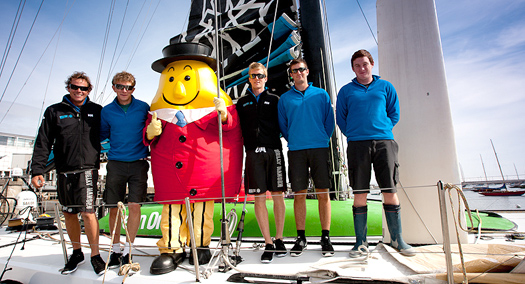
The Green Dragon crew get in some last minute training with old salt Mr. Tayto in Dun Laoghaire
An exotic fleet contains not only the 2009 Irish Round the world yacht but also eight double-handers, a number of canting keelers and three Class 40 yachts.
Sunday's start will also include more British than Irish entries, it is the first time the Irish offshore fixture counts for the same points as the Fastnet race in the 2012 Royal Ocean Racing Club programme.
Race organiser Dennis Noonan reports that the defending champion Tonnerre de Breskens from Holland who competed last weekend in Cowes at the British IRC Championships is currenlty on her way to Wicklow. Modifications to the Dutch entry for the 700-mile race include a deeper keel.
A large proportion of entries for the race are due to be inspected in Dun Laoghaire using the convenience of the town marina over the next 48 hours.
More British Than Irish Entries for 2012 Round Ireland Race
#roundireland – There will be more British than Irish entries in this month's Round Ireland race that has been boosted by a number of last minute entries.
Only last week race organiser Dennis Noonan told the Irish Times Sailing Column he expected only 33 entries but a surge of entries at the weekend has brought that figure tantalisingly close to the 2010 fleet size of 40. 37 boats are now entered and Noonan says there is a prospect of at least two more by the race start on Sunday, June 24th.
There are only 12 Irish boats compared to 18 English entries. The balance of the international fleet is made up with two boats from Northern Ireland, two from France, the defending champion from Holland and one from the USA.
Among the Irish starters is last week's winner of the ISORA race from Pwllheli to Wicklow, the yacht Lulabelle is being sailed as a double-handed entry by Liam Coyne and Fireball dinghy champion Brian Flahive.
Coyne and Flahive will count victory in last weekend’s Lynxmet mast-sponsored race as a major boost. Lula Belle is one of a handful of double-handed entries for the Round Ireland Race.
36 Entries at June 10th
| ENTRANT | CLUB | NAME | TYPE | SAIL NO |
|---|---|---|---|---|
| Peter Hall | NYC | Adelie | First 34.7 | IRL 9631 |
| James Tyrrell | Arklow SC | Aquelina | J 122 | IRL 1281 |
| Ian Hickey | RCYC | Cavatina | Granada 38 | IRL 3861 |
| Steven Anderson | RORC | Cracklin’ Rosie | Corby 40 | GBR851R |
| Nick Martin | RORC | Diablo-j | J 105 | GBR 9205R |
| Catherine Pourre | SNT (France) | Earwen | Class 40 | FRA 88 |
| Payne & Young | Poolbeg BC | English Mick | Beneteau First 47.7 | GBR 4771R |
| Rod Stuart | CCC | EOS | Elan 10 | GBR 9192R |
| Diarmuid Good | RCYC | Exhale | X362 Sport | IRL 8991 |
| Nigel Colley | Guernsey YC | Fastrak VIII | Sunfast 3200 | GBR 4690R |
| Nicholas Bate | Army SA | Fujitsu | Archambault A40RC | GBR 1429L |
| Laurent Gouy | Clifden BC | Inis Mor | Ker39 | FRA 35439 |
| Ronan O’Siochru | DMYC | IOSS- Desert Star | Sunfast 37 | IRL1397 |
| Andrew Sarratt | RIYC & RStGYC | Jedi | J109 | 8088 |
| John Maybury | RIYC | Joker 2 | J109 | IRL 1206 |
| Neil Eatough | R St.G YC | Lancasrtian | Starlight 46 | GBR 7682T |
| Coyne /Flahive | WSC | LC Tyres Lulabelle | Beneteau 36.7 | IRL3607 |
| Adrian Lee | RORC RStG | Lee Overlay Partners | Cookson 50 | IRL |
| Paul Egan | RStG | Legally Blonde | Beneteau 31.7 | IRL 3175 |
| Julian Metherell | R Thames YC | Maxvmg Fortissimo | Akilaria Class 40 | GBR 97 |
| Peter Dunlop | Pwllheli SC | Midnight Mojito | Elan 350 | GBR 1549R |
| Tom Sperrey | RORC | Nightfall | Arcona 430 | GBR 6643 |
| Sir Geoffrey Mulcahy | RTYC/RSYC | Noonmark VI | Swan 56 | GBR 5698R |
| Cathal Clarke | WIORA-NUIGSC | NUI Galway | Reflex 38 | 7386 |
| Mike Jaques | RORC | Nunatak | J120 | GBR9604R |
| Floate & Norton | IOM YC & WSC | Ocean Tango | Dehler 34 | GBR 6848T |
| Jerry Collins | RStG | Persistance | Sigma 38 | IRL 8237 |
| Kirsteen Donaldson | RORC | Pyxis | X332 | GBR 5963T |
| Michael Creedon | NYC | Sarina | S & S | IRL 2260 |
| Stephen Tudor | CH Pwllheli SC | Sgrech | J109 | GBR 9319R |
| A, B & J Douglas | Carrickfergus SC | Spirit of Jacana | J 133 | IRL 1335 |
| Dan Walsh | American YC NY | Team Wild Goose | OwenClarke Class 40 | GBR 38 |
| P W Vroon | RORC | Tonnerre de Breskens 3 | Ker 46 | NED 46 |
| T. Fair & D. Fletcher | Ballyholme YC | Twister | Beneteau 31.7 | GBR 1505R |
| Sailing Logic | RORC | Visit Malta Puma | Reflex 38 | GBR 7383R |
| Paul Jackson | RORC -JOG | Wild Spirit | Jeanneau 40SO | GBR 8799T |































